History of Sigiriya
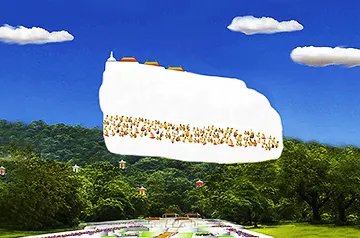
Contents
Why Was Sigiriya Built?
The history of the Sigiriya Rock Fortress, in Sri Lanka, is the tale of King Kashyapa, who ruled the Anuradhapura kingdom between 477 and 495AD. A troubled but visionary king, Kashyapa is accused of murdering his father by plastering him up in a wall. Rejected by his people for his crime and tormented by guilt he abandoned his magnificent capital of Anuradhapura and fled deep in the forests of central Sri Lanka. There, in an area dominated by a menacing black column of rock 600 feet high, he built himself a new capital resplendent with lush gardens, palaces, and pavilions.
He transformed the sinister-looking black rock to appear like a huge dazzling white cloud and painted it with beautiful frescoes of semi-naked nymphs. He also built a massive gatehouse in the form of a lion to guard the entrance to the innermost sanctum of his city, the Sky Palace on top of the rock. There, hidden from view and surrounded by his courtiers and harem, Kashyapa lived in splendid isolation. He was, however, deeply troubled by his responsibility for the death of his father. He carried out many good works and observed his religious duties diligently hoping, no doubt, to find some salvation for his troubled conscience. Finally, betrayed in battle by those he trusted, he committed suicide.
Historic Context
At the time the story of Sigiriya was unfolding in 477 AD, Sri Lanka had one of the most advanced civilizations in Asia. It sat at the crossroads between Asia and the West. Ships of many nations called into it ports and trade with far off lands such as Egypt, Roman and China prospered. Several key events took place in other parts of the world that put historical context to our story.

At about this time, the Vandals sacked Rome, and Europe began its slow, inexorable decline into the Dark Ages. The Gupta Empire controlled most of northern India, and the magnificent artworks at the Ajanta Caves commenced. These in turn had a significant influence on paintings at Sigiriya. It was also the time that an erotic compendium known as the Kama Sutra was first complied. In China, Buddhism was taking root; and in Mexico, the city of Chichén Itzá was being founded. Most of the rest of the world lay in cultural slumber.
SIGIRIYA - Novel

Palace intrigue, passion, deceit, betrayal and tragedy. Set fifteen hundred years ago, this compelling novel weaves historical facts into a remarkably entertaining story of fate, dangerous alliances, enduring friendships, and forbidden love. Available in Ebook and Paperback.
Where to Buy This BookInspiration for Sigiriya
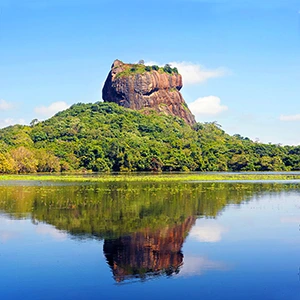
Having decided to move his capital, King Kashyapa had a grand vision. He would build his city to emulate Alakamanda. In Buddhist mythology, Alakamanda was the magnificent city of the gods. It was said to exist in a faraway place at a considerable elevation. Its ruler was Kuvera, the god of wealth and plenty.
It is from this legend that Kashyapa gained his inspiration. He would harness the vast wealth and resources of his kingdom to recreate Alakamanda on earth. It is for this reason that Kashyapa chose a location deep in the inhospitable forests of Sri Lanka. The only significant feature of the area was a menacing black rock, which rose majestically 180 meters into the air. He, Kashyapa, would transform the rock to appear as though it were a cloud. On its summit, he would build a magnificent palace and rule like a god-king.
How Sigiriya was Built
The site chosen for the capital was a foreboding place indeed, teeming with wild elephants, poisonous snakes, leopards, bears, mosquitoes, hornets, and other vermin. Kashyapa was fortunate. He was the king of an extremely prosperous kingdom. He also had a vast workforce of highly skilled laborers and artisans to do his bidding. An army of over a fifty thousand men, thousands of bullocks, and many hundreds of elephants toiled for years to build a magnificent new city in the forest.
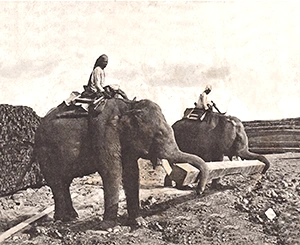
The pièce de résistance of the new city was the rock itself. It was the centerpiece of the entire city. Kashyapa and his architects built a royal citadel with ramparts and moats and lavish gardens, ponds and fountains around this looming black rock.
They constructed beautiful multi-colored pavilions, palaces, and halls. They erected grand staircases leading up to the base of the rock and then an unusual parapet wall which precariously hugged the side of the near-vertical rock face as it wound its way around the western side of the rock. This wall had such a high reflective luster that it came to be known as the Mirror Wall. They then painted the entire surface of the sinister-looking black rock in a coat of white paint so that it appeared like a massive cloud floating above the treetops. Then on the western facade of the rock was painted the largest portrait gallery in the world. This spectacular gallery consisted of over 500 stunning multi-colored frescoes depicting lightly clad semi-naked females the —Sigiriya Frescoes.
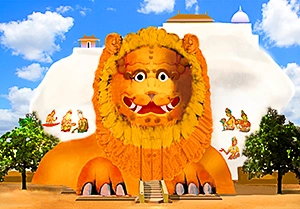
On a small plateau halfway up the rock, on the northern side, Kashyapa constructed a massive gatehouse and staircase in the form of a brightly colored sphinx-like lion thirty-five meters tall. Through its chest, via an almost perpendicular staircase, was the final ascent to the summit of the rock. It is this feature, the Lion Staircase, which in later time bestowed the place its name Sīhāgiri — Lion Mountain (Lion Rock). We know it today as Sigiriya.
Abandonment of Sigiriya
Upon Kashyapa's death, the royal capital was moved back to Anuradhapura. The magnificent Sigiriya Citadel was stripped of its treasures and converted into a Buddhist monastery. Over the ensuing centuries, it was progressively abandoned and then finally completely deserted. Slowly it was consumed by the forests and disappeared into the mists of time; forgotten, a mere footnote in history.
In time Sigiriya became a grim and foreboding place. At dusk, clouds of bats sallied forth from their lairs into the night sky, and wild animals roamed its crumbling pavilions, ponds, and gardens. The beautiful Sigiriya Frescoes faded and fell away. The palace in the sky had long ago crumbled and been carried away by the wind. For centuries, no human set foot on its summit.
Who Rediscovered Sigiriya
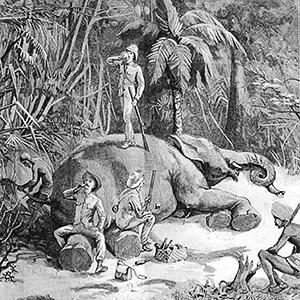
A British army officer named Jonathan Forbes, while on an elephant hunt, stumbled upon the ruins of Sigiriya in 1831. Forbes had befriended George Turnour, a British Civil Servant, who had been deciphering ancient Sri Lankan chronicles. As a consequence Forbes was well aware of the fact that a lost city lay buried in the forests.
Forbes describes how he and his companions ventured through the thick undergrowth and clambered up the dislodged steps of a series of winding stairs that zigzagged up the side of the rock and onto a walled gallery (the Mirror Wall). They proceeded along this gallery for about a hundred meters before, giddy from heat and exhaustion; they were forced to withdraw. Forbes returned in 1833 to continue his exploration of the site, noting that the projecting rock above the galley "had been painted in bright colors."These were what was left of the Sigiriya Frescoes. Serious excavation of the site commenced in 1895.
Historic References to Sigiriya
History records the magnificence of Sigiriya, only once, in these few terse words.
"He betook himself through fear to Sīhāgiri
which is difficult to ascent for human beings.
He cleared roundabout, surrounded it with a wall
and built a staircase in the form of a lion…
Then he built there a fine palace, worthy to behold,
like another Alakamanda,
and dwelt there like the god Kuvera."
Culavamsa CH 39 v2-4 (circa 1200AD)
How Sigiriya got its Name
The first authenticated use of the name Sīhāgiri (meaning Lion Mountain) appears in the Culavamsa written in the 12th century nearly 800 hundred years after Sigiriya was abandoned as the royal capital. The Culavamsa also refers to Kashyapa's palace as looking like Alakamanda. Therefore we can only say with certainty that the area was known as Sigiriya from about the 12th century AD.
This area of north-central Sri Lanka, around Sigiriya rock, has been inhabited by humans since at least 20,000 BC. However, we do not know what the place was called before the time of Kashyapa. We don't even know its name during Kashyapa's lifetime. An inscription from the tenth year of Kashyapa's rule, found at Timbirivava, makes the reference Maharaja Kasabala Alakapaya (Kashyapa King of Alakamanda). Two inscriptions attributed to King Mahinda, who ruled between 956 and 972 AD, found at Vessagiriya in Anuradhapura, use the name Kasubgiri. A literal translation of this word would be Kashyapa of the Mountain.
The proper pronunciation of this name is see-gee-ree-yah.
Ruins of the Sigiriya Today
The ruins of the Sigiriya Rock Fortress seen today are less than twenty percent of the structures that once graced the area. Most buildings were made of wood. Consequently, there is very little evidence of these structures. Those built with stone and brick have survived the ravages of time and provide us with a rare glimpse of the opulence and grandeur of an ancient era. Many ruins still lay hidden in the forest and are yet to be discovered.
The Sigiriya Citadel once occupied an area of approximately two and a half kilometers in length by one kilometer in width. The compound was divided into two precincts. The Western Precinct was the private preserve of the king, his harem and royal household. Ii incorporated formal and informal styles that represented an idealized recreation of paradise. Eye-catching gardens, ponds palaces, pavilions, large and small, halls, gateways, galleries, and towers were scattered throughout the landscape. These, in turn, lead to winding paths, natural boulders, and slopes which were ingeniously incorporated to create a series of views and tableaus. Large staircases then lead to the Mirror Wall, the spectacular Sigiriya Frescoes (which once covered the entire western face of the Sigiriya Rock), the Lion Staircase and finally the breathtaking Sky Palace on top of this 200-meter high rock.
The Eastern Precinct (not open to tourists) is mostly unexcavated and overgrown with forest. No significant archaeological ruins have been found there suggesting that the buildings in this area were predominately made of wood and were for the king's entourage and courtiers.
Sigiriya Rock Fortress, today is just a sinister-looking black rock surrounded by ruins. It is difficult for a modern tourist to comprehend the absolute splendor of the Sigiriya Rock Fortress 1600 years ago. Few ancient cities surpassed it for its ecologically-sensitive, grand vision and aesthetic elegance. It is one of the best-preserved examples of ancient urban planning in the world.
Imagine this magical place, an earthly paradise of lush gardens, ponds, fountains, and brightly colored pavilions. Its centerpiece was a huge rock which appears as though it were a large cloud tethered to earth adorned with a spectacular work of art, the Sigiriya Frescoes, which harked up to a Sky Palace on top of a 200-meter tall rock.
